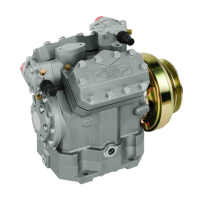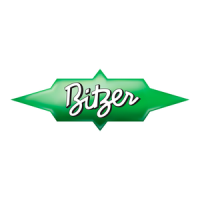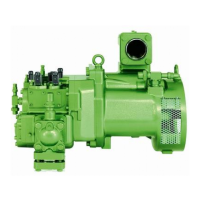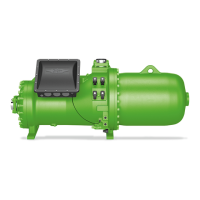15KB-570-1 RUS
ST-130-2
3
2.2 Maximale Ölniveau-Überwa-
chung
Elektrischer An schluss und Einbin -
dung in die Steue rungs logik sind von
der Konzeption der jeweiligen Anlage
abhängig.
So kann beispielsweise bei einer
Anlagenkonzeption mit überflutetem
Verdampfer ein Magnetventil in der
Ölleitung je nach Ölniveau im Verdich -
ter angesteuert werden. Ebenso ist
die Regelung einer Ölumspeisung im
Parallelver bund möglich.
2.3 Technische Daten
2.2 Monitoring of the maximum
level
The electrical connection and its inte-
gration into the control logic depend
on the design of the particular system.
Thus, for example, in an installation
with flooded evaporator, a solenoid
valve in the oil line can be activated,
depending on the oil level in the com-
pressor. Likewise, the oil circulation
can also be controlled in parallel.
2.3 Technical data
2.2 Contrôle du niveau d'huile maxi-
mal
Le raccordement électrique et l'incorpora-
tion à la logique de commande dépen-
dent de la conception de l'installation en
question.
Il est ainsi possible, par exemple dans le
cas d'une conception d'installation avec
évaporateur noyé, de commander une
vanne magnétique dans la conduite d'hui-
le, suivant le niveau d'huile dans le com-
presseur. La régulation d'un transfert
d'huile dans des compresseurs en
parallèle est également possible.
2.3 Données tech ni ques
Anschluss-Spannung Supply volt age Tension d'alimentation 230 V AC ± 10%
Netzfrequenz Supply frequency Fréquence du réseau 50 / 60 Hz
Verzögerungszeit (integriert) Delay time (integrated) Temporisation (integré) 5 s ± 2 s
Vorsicherung für Gerät Fusing for device and Fusible pour appareil et
und Schaltkontakte switch contacts contacts de commutation
Maximal zulässiger Druck Maximum allowable pressure Pression maximale admissible
Anschlusskabel Connecting cable Câble de raccordement
Kältemaschinenöle Refrigeration compressor oil Huiles pour machines frigorifiques alle / all / toutes
Kältemittel Refrigerants Fluides frigorigènes
Schutzart (montiert) Enclosure class (mounted) Classe de protection (monté) IP54
Zulässige Umgebungstemperatur Allowable ambient temperature Température ambiante admissible -30 .. +60°C
Gewicht Weight Poids 390 g
Opto-elektronische Einheit wird als
OLC-D1 ausgeliefert (siehe Seite 2,
Abbildung 1, Position 4)
andere Spannungen auf Anfrage,
auch mit UL-Abnahme erhältlich
Kabel sind farbkodiert
Opto-electronic unit is delivered as
OLC-D1 (see page 2, figure 1, pos. 4)
other voltages upon request, also
available with UL approval
Cables are color coded
Le composant opto-électronique est livrée
comme OLC-D1 (voir page 2, figure 1,
position 4)
d'autres types de tension sur demande,
aussi avec contrôle UL
Câbles avec code couleur
5 x AWG 20 (0,75 mm
2
)
L = 2 m
HFKW, (H)FCKW
HFC, (H)CFC
Relais-Ausgänge: Relay output: Sorties de relais:
Schaltspannung Switching voltage Tension de commutation max. 240 V AC
Schaltstrom Switching current Intensité de commutation max. 2,5 A
Schaltleistung Switching capacity Puissance de commutation max. 300 VA
max. 4 A
Maximale Öltemperatur Maximum oil temperature Température d'huile maximale 120°C
33 bar (-20°C .. -10°C)
45 bar (-10°C .. 120°C)
Geräte-Typ Device type Type de dispositif OLC-D1-S
5.4 Kältemitteleinfüllen
Nur zugelassene Kältemittel einfüllen
(siehe Kapitel 2).
• BevorKältemitteleingefülltwird:
- Ölstand im Verdichter
kontrollieren.
- Verdichter nicht einschalten!
• FlüssigesKältemitteldirektinden
Verflüssiger bzw. Sammler füllen.
• NachInbetriebnahmekannes
notwendig werden, Kältemittel zu
ergänzen:
Bei laufendem Verdichter Kälte-
mittel auf der Saugseite einfüllen,
am besten am Verdampfer-Eintritt.
Bei Flüssigkeits-Einspeisung:
Achtung!
Gefahr von Nassbetrieb!
Äußerst fein dosieren!
Öltemperatur oberhalb 40°C
halten.
Gefahr!
Berstgefahr von Komponenten
und Rohrleitungen durch hydrau-
lischen Überdruck.
Überfüllung des Systems mit
Kältemittel unbedingt vermeiden!
5.5 Kontrollen vor dem Start
• Ölstand
(im markierten Schauglasbereich)
Bei Verdichter-Austausch:
Achtung!
Es befindet sich bereits Öl im
Kreislauf. Deshalb kann es
erforderlich sein, einen Teil der
Ölfüllung abzulassen.
Bei größeren Ölmengen im Kreis -
lauf (z. B. durch vorausgegangenen
Verdichterschaden) besteht zudem
Gefahr von Flüs sigkeitsschlägen
beim Startvorgang
.
Ölstand innerhalb markiertem
Schauglasbereich halten!
• EinstellungundFunktionder
Sicherheits- und Schutz-Ein-
richtungen
• AbschaltdrückederHoch-und
Niederdruck-Wächter
• Absperrventillegeöffnet?
5.4 Chargingrefrigerant
Charge only permitted refrigerants
(see chapter 2).
• Beforerefrigerantischarged:
- Check the compressor oil level.
- Do not switch on the compressor!
• Chargeliquidrefrigerantdirectly
into the condenser resp. receiver.
• Aftercommissioningitmaybe
necessary to add refrigerant:
Charge the refrigerant from the
suction side while the compressor
is in operation. Charge preferably
at the evaporator inlet.
If liquid is charged:
Attention!
Danger of wet operation!
Charge small amounts at a time!
Keep the oil temperature above
40°C.
Danger!
Explosion risk of components
and pipelines by hydraulic
overpressure.
Avoid absolutely overcharging of
the system with refrigerant!
5.5 Checks before starting
• Oillevel
(within range on sight glass)
When exchanging a compressor:
Attention!
Oil is already in the system.
Therefore it may be necessary
to drain a part of the oil charge.
If there are large quantities of
oil in the circuit (possibly from a
pre ceding compressor damage),
there is also a risk of liquid
slugging at start.
Adjust oil level within the marked
sight glas range!
• Settingandfunctionofsafetyand
protection devices
• Cut-outpressuresofthehigh-and
low-pressure limiters
• Aretheshut-offvalvesopened?
5.4 Заправка хладагентом
Заправляйте только разрешенные
хладагенты (см. главу 2).
• Перед заправкой хладагента:
-
Проверьте уровень масла в
компрессоре!
-
Не включайте компрессор!
• Заправляйте жидкий хладагент
непосредственно в конденсатор или
ресивер.
• После ввода в эксплуатацию может
потребоваться дополнительная
заправка хладагента: Заправляйте
хладагент со стороны всасывания
во время работы компрессора.
Предпочтительно заправлять на входе
в испаритель.
При заправке жидкостью:
Внимание!
Опасность влажного хода!
Заправляйте небольшое количество
за один раз! Температуру масла
поддерживайте выше 40°C.
Опасность!
Опасность взрыва компонентов и
трубопроводов из-за избыточного
гидравлического давления.
Избыточная заправка хладагентом
абсолютно недопустима.
5.5 Проверки перед пуском
• Уровень масла
(в пределах смотрового стекла)
В случае замены компрессора:
Внимание!
Масло уже находится в системе.
Поэтому может возникнуть
необходимость слить часть масла.
При наличии большого количества
масла в контуре (возможно, от
предыдущего компрессора, выше-
дшего из строя), также существует
риск гидроудара при пуске.
Скорректируйте уровень масла
в пределах обозначенной зоны
смотрового стекла!
• Настройки и функционирование
устройств защиты и безопасности
• Величина давления отключения реле
высокого и низкого давления
• Открыты ли запорные клапаны?

